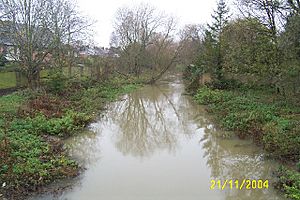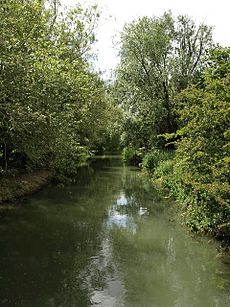Bulstake Stream facts for kids
The Bulstake Stream, sometimes spelled Bullstake Stream, is a special waterway in Oxford, England. It's known as a "backwater" of the River Thames. This means it's a smaller channel that branches off from the main river and then usually rejoins it later.
Contents
What is the Bulstake Stream?
The Bulstake Stream is like a side path for the River Thames. It starts its journey at a place called Four Rivers. This spot is at the southwest corner of Fiddler's Island, right across from the Sheepwash Channel.
A Place for Fun: Tumbling Bay
Right after it starts, the stream flows past an area known as Tumbling Bay. For many years, from 1853 to 1990, this was a popular spot for people to go swimming! Imagine a natural swimming pool right in the stream.
Its Winding Path
The Bulstake Stream takes a bit of a scenic route. First, a smaller channel called Osney Ditch flows out of it, heading southeast towards Osney.
The main stream then curves around, going west and then south. Along its path, it passes under a few bridges. You can find it flowing under bridges on Binsey Lane and Botley Road. The bridge on Botley Road is even named after it: Bulstake Bridge.
Eventually, the Bulstake Stream meets up with another stream called the Hinksey Stream (also known as Seacourt Stream) near North Hinksey.
Rejoining the Thames
After its meeting with the Hinksey Stream, the Bulstake Stream continues its journey, heading east. It flows past the Osney Mead Industrial Estate. Finally, it rejoins the main River Thames near the Osney Rail Bridge.
The famous Thames Path, a long-distance walking trail, also crosses the Bulstake Stream. It does this on a bridge known as Boney's Bridge. Another stream, called Botley Stream, flows into the Bulstake Stream from the Seacourt Stream, just north of Botley Road.
Other Names for the Stream
The lower part of the Bulstake Stream, after it resumes its journey, is sometimes called Potts Stream or Pot Stream.
A Bit of History
For a long time, until the year 1790, the Bulstake Stream was actually the main way boats traveled on the River Thames in this area! It was the primary navigation channel. However, when the Osney Lock was built and opened in 1790, the main path for boats changed. That's when the Bulstake Stream became a quieter "backwater" instead of the main route.



